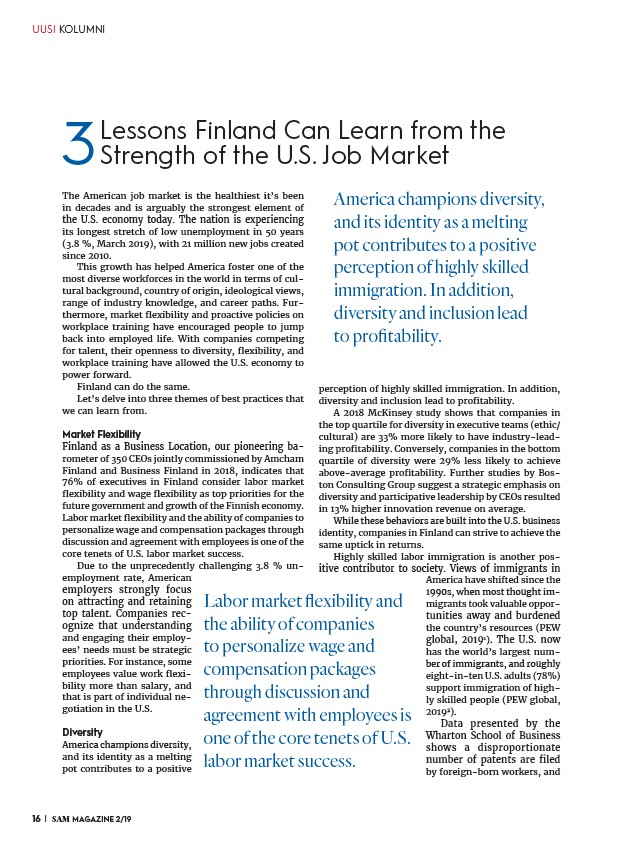
3 Lessons Finland Can Learn from the
Strength of the U.S. Job Market
The American job market is the healthiest it’s been
in decades and is arguably the strongest element of
the U.S. economy today. The nation is experiencing
its longest stretch of low unemployment in 50 years
(3.8 %, March 2019), with 21 million new jobs created
since 2010.
This growth has helped America foster one of the
most diverse workforces in the world in terms of cultural
background, country of origin, ideological views,
range of industry knowledge, and career paths. Furthermore,
market flexibility and proactive policies on
workplace training have encouraged people to jump
back into employed life. With companies competing
for talent, their openness to diversity, flexibility, and
workplace training have allowed the U.S. economy to
power forward.
Finland can do the same.
Let’s delve into three themes of best practices that
we can learn from.
Market Flexibility
Finland as a Business Location, our pioneering barometer
of 350 CEOs jointly commissioned by Amcham
Finland and Business Finland in 2018, indicates that
76% of executives in Finland consider labor market
flexibility and wage flexibility as top priorities for the
future government and growth of the Finnish economy.
Labor market flexibility and the ability of companies to
personalize wage and compensation packages through
discussion and agreement with employees is one of the
core tenets of U.S. labor market success.
Due to the unprecedently challenging 3.8 % unemployment
rate, American
employers strongly focus
on attracting and retaining
top talent. Companies recognize
that understanding
and engaging their employees’
needs must be strategic
priorities. For instance, some
employees value work flexibility
more than salary, and
that is part of individual negotiation
in the U.S.
Diversity
America champions diversity,
and its identity as a melting
pot contributes to a positive
America champions diversity,
and its identity as a melting
pot contributes to a positive
perception of highly skilled
immigration. In addition,
diversity and inclusion lead
to profitability.
perception of highly skilled immigration. In addition,
diversity and inclusion lead to profitability.
A 2018 McKinsey study shows that companies in
the top quartile for diversity in executive teams (ethic/
cultural) are 33% more likely to have industry-leading
profitability. Conversely, companies in the bottom
quartile of diversity were 29% less likely to achieve
above-average profitability. Further studies by Boston
Consulting Group suggest a strategic emphasis on
diversity and participative leadership by CEOs resulted
in 13% higher innovation revenue on average.
While these behaviors are built into the U.S. business
identity, companies in Finland can strive to achieve the
same uptick in returns.
Highly skilled labor immigration is another positive
contributor to society. Views of immigrants in
America have shifted since the
1990s, when most thought immigrants
took valuable opportunities
away and burdened
the country’s resources (PEW
global, 20191). The U.S. now
has the world’s largest number
of immigrants, and roughly
eight-in-ten U.S. adults (78%)
support immigration of highly
skilled people (PEW global,
20192).
Data presented by the
Wharton School of Business
shows a disproportionate
number of patents are filed
by foreign-born workers, and
UUSI KOLUMNI
Labor market flexibility and
the ability of companies
to personalize wage and
compensation packages
through discussion and
agreement with employees is
one of the core tenets of U.S.
labor market success.
16 | SAM MAGAZINE 2/19